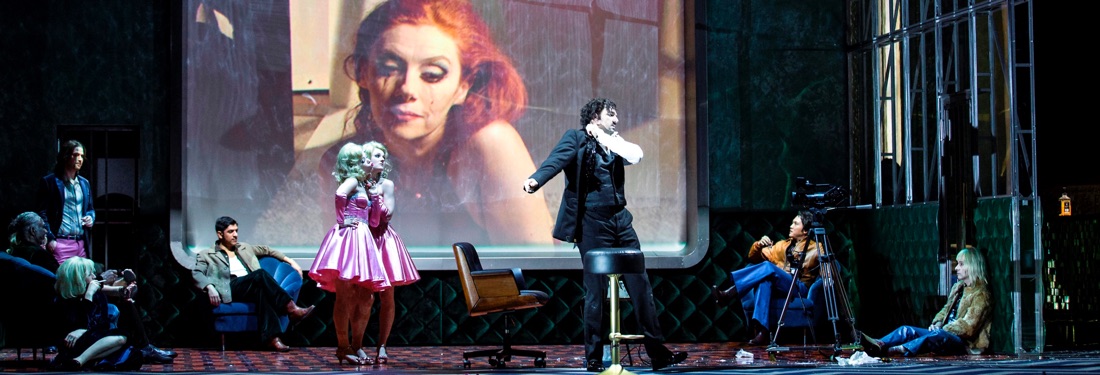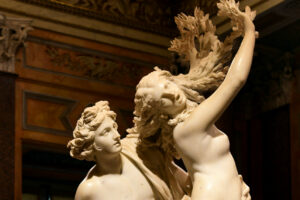

Well, now that her second opera, Breaking the Waves, has received its New York premiere as part of the Prototype Festival of new musical theater works, I can confess something: when I read those words, I sighed just a little at the hyperbole of over-optimistic classical music critics. I have always enjoyed Mazzoli’s uncanny and highly original music, and held out great hopes for her success—her first opera, the dreamlike Song from the Uproar, was a rich and effective work—but I just didn’t think of her as a composer of, for lack of a less insulting phrase, “real opera.”
You know what I mean, right? Something more drama than ritual, something with a pit orchestra that you couldn’t fit into a station wagon—something, in other words, that you might hear at the Met. That’s no shade! She had demonstrated her mastery of the chamber-music-plus-electronics format that at the time was proving especially popular among composers of her generation, and who wants to write an opera with a plot nowadays anyway? Like, how often does that even work with the aesthetics of a genuinely innovative composer?
Well, I can confess these misgivings to you now, dear reader, because now that I have seen Breaking the Waves, I can assure you that I was full of shit. I was 100% wrong, and Smith is starting to seem very, very right. Breaking the Waves is not only a “real opera,” it is an immensely powerful work of music drama.
Based on Lars Von Trier‘s film, the plot operates where the conventions of moralistic melodrama, and its fixation on female purity, intersect with the conventions of pornography à la Sade. When her husband Jan (baritone John Moore) is horribly injured by an accident at an oil rig, the pathologically goodhearted Bess (soprano Kiera Duffy)—confused by the paralyzed Jan’s sexual fantasies and by her own guilt at his condition—is told by the voice of God that she can keep her husband alive by debasing herself sexually for strangers. The most perverse twist of all is that it works: when she drops dead after being sexually tortured by sailors, her husband rises from his hospital bed and walks.
Mazzoli’s musical voice has always been bittersweet, its placid, lyrical surface troubled by uneasy lurches of harmony. Breaking the Waves proves that she is also capable of music of brutal force. Adam Rigg‘s brilliant set in this production resembles the massive shards of an ominous ruin, or of the frozen wastes of Caspar David Friedrich‘s painting The Sea of Ice, and that might be the best way to describe the score, too: not just troubled, its brittle surface is often shattered by violent upheavals.
The pit band for Breaking the Waves is not terribly large, but Mazzoli’s writing for these 14 members of the NOVUS NY Orchestra, packed with luminaries from the local new-music scene, proved boundlessly varied—Taylor Levine played electric guitar; bassoonist Brad Balliett doubled on the contra; the tremendous percussionist Ian Rosenbaum scraped a metal brake drum and blew through a melodica.
Music director Julian Wachner, of Trinity Church Wall Street, steered the soloists, chorus and orchestra fearlessly through the scores uneven rhythmic layers and shaped each sound deftly. There was no shortage of talent in the pit, but I hope you’ll forgive me for wondering what Mazzoli could do with the Met Orchestra.
And can she write for singers? Oh, yes. Not only do Duffy and Moore—who, on top of their delicious vocal performances, look beautiful and act marvelously—get the prerequisite lyrical love duets and arias, the supporting roles are distinctively and flatteringly written. The doctor who treats the couple (Dominic Armstrong) gets tenor melismas reminiscent of Britten’s writing for Peter Pears, while baritone Marcus DeLoach, as Bess’s minister, gets to show off the full luster of his cello-like tone, and there’s even an exhilarating trio for Jan, the doctor, and Bess’s supportive sister-in-law Dodo (Eve Gigliotti).
Perhaps most satisfying is Mazzoli’s writing for the men’s chorus that doubles as the oilworkers (in “Anvil Chorus”-like unison), the disapproving patriarchy of Bess’s church (in Lutheran chorales), and the creepy, disturbing voice of God (slipping, at times, into psychotic asynchrony). During the big, climactic chorus, when Bess is finally sacrificing herself completely, I got a rash of goosebumps all over my body that refused to subside.
James Darrah‘s production, imported from the Philadelphia Opera, was appropriately grim, spare, and efficient. Under his direction, the entire cast offered utterly convincing portrayals, especially Duffy’s transformation from self-repression, to self-discovery, to self-destruction, and the sensational elements of the plot were staged for maximum emotional impact without seeming exploitative—has onstage nudity ever seemed so vulnerable? And Royce Vavrek‘s libretto was a model of the sort of structural clarity that opera demands, setting up musical moments and advancing the plot and then getting the heck out of the way.
Mazzoli hasn’t made it to the stage of the Met quite yet. But if there wasn’t at least one impresario in the audience on Friday night who looked at the terrific resources she was working with, saw just how much she achieved with them, and didn’t then at least think, I wonder what she could do with twice that much, then there is no hope for the form.
Photo: Nicholas Korkos

























Comments